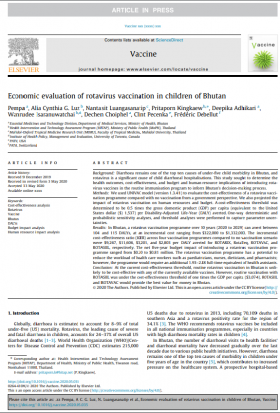This website uses cookies so that we can provide you with the best user experience possible. Cookie information is stored in your browser and performs functions such as recognising you when you return to our website and helping our team to understand which sections of the website you find most interesting and useful.
Economic evaluation of rotavirus vaccination in children of Bhutan

รายละเอียดเพิ่มเติม
Abstract
Background: Diarrhoea remains one of the top ten causes of under-five child morbidity in Bhutan, and rotavirus is a significant cause of child diarrhoeal hospitalisations. This study sought to determine the health outcomes, cost-effectiveness, and budget and human resource implications of introducing rotavirus vaccines in the routine immunisation program to inform Bhutan’s decision-making process.
Methods: We used UNIVAC model (version 1.3.41) to evaluate the cost-effectiveness of a rotavirus vaccination programme compared with no vaccination from a government perspective. We also projected the impact of rotavirus vaccination on human resources and budget. A cost-effectiveness threshold was determined to be 0.5 times the gross domestic product (GDP) per capita (equivalent to the United States dollar ($) 1,537) per Disability-Adjusted Life-Year (DALY) averted. One-way deterministic and probabilistic sensitivity analyses, and threshold analyses were performed to capture parameter uncertainties.
Results: In Bhutan, a rotavirus vaccination programme over 10 years (2020 to 2029) can avert between 104 and 115 DALYs, at an incremental cost ranging from $322,000 to $1,332,000. The incremental cost-effectiveness ratio (ICER) across four vaccination programmes compared to no vaccination scenario were $9,267, $11,606, $3,201, and $2,803 per DALY averted for ROTARIX, RotaTeq, ROTAVAC, and ROTASIIL, respectively. The net five-year budget impact of introducing a rotavirus vaccination programme ranged from $0.20 to $0.81 million. The rotavirus vaccination programme has a potential to reduce the workload of health care workers such as paediatricians, nurses, ieticians, and pharmacists; however, the programme would require an additional 1.93–2.88 full-time equivalent of health assistants.
Conclusion: At the current cost-effectiveness threshold, routine rotavirus vaccination in Bhutan is unlikely to be cost-effective with any of the currently available vaccines. However, routine vaccination with ROTASIIL was under the cost-effectiveness threshold of one times the GDP per capita ($3,074). ROTASIIL and ROTAVAC would provide the best value for money in Bhutan.




